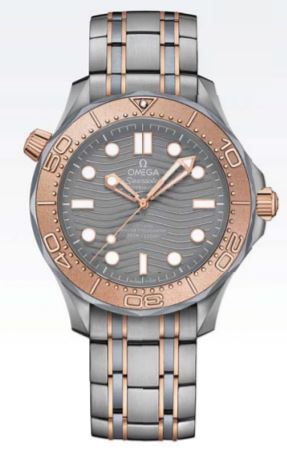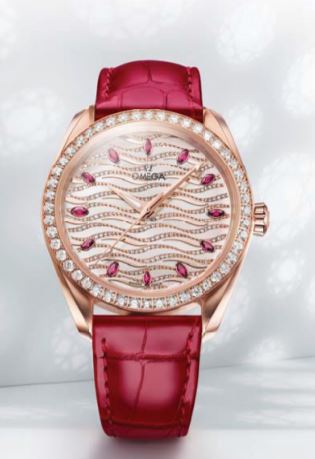SINGAPORE (Aug 20): A watchmaker that traverses the deep blue as nimbly as deep space had better be confident of the territories it navigates. Omega shows no qualms, evidently certain it will not be caught unprepared in its relationships with ocean or Moon.
Vast distance might separate them, but both are entities regarded with wonder by those bound to Earth. What science tells us of them does not remotely dispel their romance — instead, the more we discover and understand, the more magnificent their delicate yet dangerous environments appear to us. And then there are the gifts that inhabit the environment between sea and space; the bounties of Earth in all their sparkling splendour. Jewels retrieved and refined from exclusive mines are treated with reverence by Omega, which captures the blend of mysticism and realism of these subjects in exquisite timepieces.
Since its inception in 1993, the Seamaster Diver 300M has enjoyed a loyal following, driven by admiration for its design and ocean technology. The original timepiece signalled Omega’s triumphant return to the platform of diving watches as well as ignited a still-enduring partnership with James Bond, the ultimate onscreen secret agent. Twenty-five years after its inauguration, the iconic model has been treated to a full facelift in keeping with today’s tastes.
In addition to the 55-hour power reserve, the calibre also controls the date, moved from 3 o’clock to 6 o’clock for greater visual symmetry. New dive watch regulations dictate that all hour markers need to be visible on a timepiece certified for diving, so the latest Omega Seamaster 300M features a stub beneath the date window to honour the directive. Indices have been raised and filled with Super-LumiNova, making this among the most legible dive watches on the market. This is saying something indeed, given that the model reclaims another original feature in this generation: the wave pattern, now laser-engraved, which creates a highly decorated, textured dial. It’s a welcome feature, instantly identifying the piece as one intended for the sea.
We make our way out of the ocean onto terra firma, where the Seamaster Aqua Terra Jewellery (pictured, left) awaits. The bedazzling escort to the above sporty counterpart, it calls a slender 38mm 18-carat Sedna gold case home. A diamond-paved bezel frames a symphony of silver, gold and precious stones, its most remarkable quality being the horizontal waves that mimic the undulating rhythm of the ocean and impart a sense of movement. Silvery guilloche waves are interspersed with those in 18-carat Sedna gold as well as diamond-studded Sedna gold swells. Gold hands, with luminescent underscores on the trunk of the hour hand and the arrowed tip of the minute hand, point at marquise-cut rubies that denote the hours. Driving the hands is the Master Chronometer Calibre 8807, which supplies the piece with the accuracy and flawless operation it deserves.
Vast distance might separate them, but both are entities regarded with wonder by those bound to Earth. What science tells us of them does not remotely dispel their romance — instead, the more we discover and understand, the more magnificent their delicate yet dangerous environments appear to us. And then there are the gifts that inhabit the environment between sea and space; the bounties of Earth in all their sparkling splendour. Jewels retrieved and refined from exclusive mines are treated with reverence by Omega, which captures the blend of mysticism and realism of these subjects in exquisite timepieces. Since its inception in 1993, the Seamaster Diver 300M has enjoyed a loyal following, driven by admiration for its design and ocean technology. The original timepiece signalled Omega’s triumphant return to the platform of diving watches as well as ignited a still-enduring partnership with James Bond, the ultimate onscreen secret agent. Twenty-five years after its inauguration, the iconic model has been treated to a full facelift in keeping with today’s tastes.
Since its inception in 1993, the Seamaster Diver 300M has enjoyed a loyal following, driven by admiration for its design and ocean technology. The original timepiece signalled Omega’s triumphant return to the platform of diving watches as well as ignited a still-enduring partnership with James Bond, the ultimate onscreen secret agent. Twenty-five years after its inauguration, the iconic model has been treated to a full facelift in keeping with today’s tastes.
The case has been widened to 42mm to better host the new Master Chronometer Calibre 8800. Omega has been investing heavily in ensuring all its in-house manufactured calibres are METAS certified to guarantee the highest standards of precision and chronometric performance possible. As a testament to this commitment, it opened a factory last year that is set to increase the efficiency and capacity of testing and certification. The Calibre 8800 is an automatic movement with a co-axial escapement and a silicon hairspring that wards off magnetic influence, granting the movement — which can be viewed through the new sapphire crystal caseback — exceptional precision.
Speaking of which, the manual helium release valve at 10 o’clock, a patented technology that allows the watch to be operated underwater, is redesigned with a conical valve. Water resistance is still 300m as per the model name. Omega launched the new generation of Seamaster Diver 300M watches in 14 unique models, some in pure stainless steel and some with gold accents, but the climax of the collection is undoubtedly the 2,500-piece limited edition model in titanium tantalum. Blue-grey tantalum forms the base of the bezel as well as the middle links of the bracelet, juxtaposed against Grade 2 titanium in the brushed case and bracelet, while 18-carat Sedna gold caresses the crown, helium escape valve, bezel ring, bracelet links and subtly redesigned skeleton hands.
The same conical crown of the Seamaster Dive 300M makes an appearance here, wrapped in Sedna gold and polished with an Omega logo on a matte surface. One elegant lug is connected to the other by means of a glossy red leather strap, affirming the piece as the epitome of femininity.
Having conquered sea and land, Omega returns to a territory alien to most others, but a landscape that welcomes it with some familiarity. The watchmaker made timekeeping history in 1965 when Nasa qualified a Speedmaster for use on piloted missions after ascertaining its durability under extreme conditions. Neil Armstrong left his Speedmaster on board when he stepped into space but Buzz Aldrin had his strapped to the outside of his spacesuit in that 1969 mission of the Apollo 11. The model earned the nickname “the Moonwatch”, becoming one of the most significant wristwatches in the 20th century and marking the start of Omega’s official space legacy, heralding participation in Moon landings that followed.
The Speedmaster Dark Side of the Moon Apollo 8
However, it is an earlier mission to which the watchmaker alludes in its new Speedmaster. The Dark Side of the Moon Apollo 8 references the first manned spaceflight mission to the Moon that saw three astronauts — Commander Frank Borman, Command Module Pilot Jim Lovell, and Lunar Module Pilot William Anders — live broadcast their entrance into lunar orbit on Christmas Eve in 1968. “We’ll see you on the other side,” said Lovell just before the crew’s pioneering orbit to the dark side of the Moon that would see radio communications cut off for a nerve-wracking 34 minutes.
Omega immortalises the sanguine sentence by engraving it onto the black ceramic exhibition caseback of the Dark Side of the Moon Apollo 8. Within the sapphire crystal pane, a movement of extraordinary detailing thrums — the Calibre 1861 was resuscitated as the Calibre 1869 in tribute to the first Moon landing. It is blackened and intricately decorated with laser ablations applied onto the bridges and main plate to realistically reconstruct known lunar imagery right down to the uneven surfaces. To authentically carry through the illustration, the front and back are outfitted in different shades: the former lighter to represent our view of the Moon’s surface from Earth while the latter, from behind the exhibition pane, waxes a deeper hue to signify the dark side only astronauts get to see.
The rest of the timepiece radiates out from the movement with the same spirit of purpose. The entire 44.25mm watch is forged from black zirconium oxide ceramic with yellow colour coding for contrast, a throwback to the ethos of a 1968 Speedmaster Racing model that instigated the association of the colour with speed. Chronograph hands are varnished yellow while the tachymeter scale and crown are filled with Super-LumiNova for quick readability. Extending from either end of the case are leather straps that uphold the chosen scheme, the black leather enveloping a section of yellow rubber in its middle. A milling tool was used to create micro-perforations through the constructed strap to reveal hints of yellow within, the colour further endorsed with contrast stitching.
Such ventures authentically connect us to times and places beyond our grasp, linking us to the mysterious hemispheres or landscapes few among us will ever truly know. Many of us will never have the chance to put these pieces to the test in the conditions they were constructed to withstand but we wear on our wrists the hope of such a possibility and the assurance that should such circumstances arise, we will not be found wanting.
Petrina Fernandez is a senior writer with The Edge Malaysia.
This article appeared in Issue 844 (Aug 20) of The Edge Singapore.


